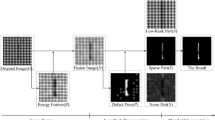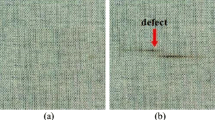Abstract
Low-rank decomposition model is widely used in fabric defect detection, where a feature matrix is decomposed into a low-rank matrix that represents defect-free regions of the image and a sparse matrix that represents defective regions. Two shortcomings, however, still exist in the traditional low-rank decomposition models. First, they cannot detect the position and shape of the defect very well, and they are usually misjudge the textured background as a defect. Second, they cannot detect some large homogeneous defective block. To solve those problems, we propose a low-rank decomposition model with defect prior and total variation regular term, we call it PTVLR. And it is consisted of the following parts. (1) Defect prior, which characterizes the autoencoder residual image, is used as a prior consideration of detect for improving the separation effect of low-rank texture and defect, (2) total variation regular of term constrains the defect according to the spatial continuity of the defect, (3) \({L_F}\) norm characterizes the image noise part. The performance of PTVLR is evaluated on the box-, star- and dot- patterned fabric databases. And its superior results are shown compared with state-of-the-art methods, that is, 55.58% f-measure and 77.89% true positive rate (TPR) for box-patterned fabrics, 53.20% f-measure and 86.75% TPR for star-patterned fabrics, 69.78% f-measure and 88.33% TPR for dot-patterned fabrics.

















Similar content being viewed by others
References
Selvi, S.S., Nasira, G.M.: An effective automatic fabric defect detection system using digital image processing. J. Environ. Nanotechnol. 6(1), 79–85 (2017)
Tsang, C.S.C., Ngan, H.Y.T., Pang, G.K.H.: Fabric Inspection Based on the Elo Rating Method. Elsevier, Amsterdam (2016)
Ngan, H.Y.T., Pang, G.K.H.: Novel method for patterned fabric inspection using Bollinger bands. Opt. Eng. 45(8), 087202 (2006)
Ngan, H.Y.T., Pang, G.K.H.: Regularity analysis for patterned texture inspection. IEEE Trans. Autom. Sci. Eng. 6(1), 131–144 (2008)
Ngan, H.Y.T., et al.: Wavelet based methods on patterned fabric defect detection. Pattern Recognit. 38(4), 559–576 (2005)
Ngan, H.Y.T., Pang, G.K.H, Yung, S.P., et al.: Defect detection on patterned jacquard fabric. In: Applied Imagery Pattern Recognition Workshop (2003)
Chang, X., Gu, C., Liang, J., et al.: Fabric defect detection based on pattern template correction. Math. Probl. Eng. 2018, 1–17 (2018)
Ng, M.K., et al.: Patterned fabric inspection and visualization by the method of image decomposition. IEEE Trans. Autom. Sci. Eng. 11(3), 943–947 (2014)
Ng, M.K., et al.: Lattice-based patterned fabric inspection by using total variation with sparsity and low-rank representations. SIAM J. Imaging Sci. 10(4), 2140–2164 (2017)
Ji, X., Liang, J., Di, L., et al.: Fabric defect fetection via weighted low-rank decomposition and Laplacian regularization. J. Eng. Fibers Fabr. 15, 1558925020957654 (2020)
Li, C., et al.: Defect detection for patterned fabric images based on GHOG and low-rank decomposition. IEEE Access 7, 83962–83973 (2019)
Liu, G., Zheng, X.: Fabric defect detection based on information entropy and frequency domain saliency. Vis. Comput. 24 (2020)
Bi, L., Kim, J., Kumar, A., Fulham, M., Feng, D.: Stacked fully convolutional networks with multi-channel learning: application to medical image segmentation. Vis. Comput. 33(68), 10611071 (2017)
Yuan, H. et al.: A deep convolutional neural network for detection of rail surface defect. In: 2019 IEEE Vehicle Power and Propulsion Conference (VPPC). IEEE (2019)
Li, Y., Huang, H., Xie, Q., Yao, L., Chen, Q.: Research on a surface defect detection algorithm based on MobileNet-SSD. Appl. Sci. 8, 1678 (2018)
Bergmann, P., et al.: Improving unsupervised defect segmentation by applying structural similarity to autoencoders. arXiv:1807.02011 (2019)
Gong, D., Liu, L., Le, V., et al.: Memorizing normality to detect anomaly: memory-augmented deep autoencoder for unsupervised anomaly detection. In: 2019 IEEE/CVF International Conference on Computer Vision (ICCV). IEEE (2020)
Giraldo-Zuluaga, J.H., Salazar, A., Gomez, A., et al.: Camera-trap images segmentation using multi-layer robust principal component analysis. Vis. Comput. 35, 335347 (2019)
Cao, J., Wang, N., Zhang, J., Wen, Z., Li, B., Liu, X.: Detection of varied defects in diverse fabric images via modified RPCA with noise term and defect prior. Int. J. Clothing Sci. Technol. 28(4), 516529 (2016)
Liu, G., Li, F.: Fabric defect detection based on low-rank decomposition with structural constraints. Vis. Comput. (2021)
Candes, E.J., Li, X., Ma, Y., et al.: Robust principal component analysis. J. ACM 58(3), 1–37 (2011)
Wang, Z., Bovik, A.C., Sheikh, H.R., Simoncelli, E.P.: Image quality assessment: from error visibility to structural similarity. IEEE Trans. Image Process. 13(4), 600612 (2004)
Rudin, L.I., Osher, S., Fatemi, E.: Nonlinear total variation based noise removal algorithms. In: Eleventh International Conference of the Center for Nonlinear Studies on Experimental Mathematics: Computational Issues in Nonlinear Science: Computational Issues in Nonlinear Science. Elsevier North-Holland, Inc. (1992)
Zheng, Z., Yu, M., Jia, J., et al.: Fisher discrimination based low rank matrix recovery for face recognition. Pattern Recognit 47(11), 3502–3511 (2014)
Cai, J.F., Cands, E.J., Shen, Z.: A singular value thresholding algorithm for matrix completion. SIAM J. Optim. 20(4), 1956–1982 (2010)
Beck, A., Teboulle, M.: A fast iterative shrinkage-thresholding algorithm for linear inverse problems. SIAM J. Imaging Sci. 2(1), 183–202 (2009)
Goldstein, T., Osher, S.: The split Bregman method for L1-regularized problems. SIAM J. Imaging Sci. 2(2), 323–343 (2009)
Zhoufeng, L., Jiuge, W., Quanjun, Z., et al.: Research on fabric defect detection algorithm based on improved adaptive threshold. Microcomput. Appl. 10, 016 (2013)
Mei, S., Wang, Y., Wen, G.: Automatic fabric defect detection with a multi-scale convolutional denoising autoencoder network model. Sensors 18(4), 1064 (2018)
Doyle, L., Mould, D.: Augmenting photographs with textures using the Laplacian pyramid. Vis. Comput. 35(10), 14891500 (2019)
Kingma, D.P., Ba, J.: A method for stochastic optimization. In: International Conference on Learning Representations (2015)
Acknowledgements
This study is supported by Jiangsu Engineering Research Center of Digital Twinning Technology for Key Equipment in Petrochemical Process (No. DT 2020720), Jiangsu Engineering Research Center of Digital Twinning Technology for Key Equipment in Petrochemical Process (DTEC202001, DT2020720) and the Postgraduate Research & Practice Innovation Program of Jiangsu Province (YPC20020171). The database employed in this research is kindly provided by Industrial Automation Research Laboratory from Department of Electrical and Electronic Engineering of Hong Kong University. The dataset is available at (https://lmb.informat-ik.unifreiburg.de/resources/datasets/tilda.en.html).
Author information
Authors and Affiliations
Corresponding author
Additional information
Publisher's Note
Springer Nature remains neutral with regard to jurisdictional claims in published maps and institutional affiliations.
Rights and permissions
About this article
Cite this article
Bao, X., Liang, J., Xia, Y. et al. Low-rank decomposition fabric defect detection based on prior and total variation regularization. Vis Comput 38, 2707–2721 (2022). https://doi.org/10.1007/s00371-021-02148-9
Accepted:
Published:
Issue Date:
DOI: https://doi.org/10.1007/s00371-021-02148-9




